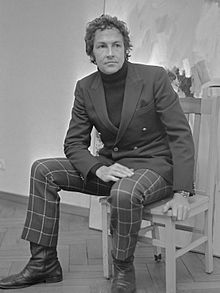Robert Rauschenberg | |
|---|---|
 Rauschenberg in 1968 | |
| Born | Milton Ernest Rauschenberg October 22, 1925 Port Arthur, Texas, U.S. |
| Died | May 12, 2008 (aged 82) Captiva, Florida, U.S. |
| Education | Kansas City Art Institute Académie Julian Black Mountain College Art Students League of New York |
| Known for | Assemblage |
| Notable work | Canyon (1959) Monogram (1959) |
| Movement | Neo-Dada, Abstract expressionism, Pop art |
| Spouse | |
| Awards | Leonardo da Vinci World Award of Arts (1995) Praemium Imperiale (1998) |
Milton Ernest "Robert" Rauschenberg (October 22, 1925 – May 12, 2008) was an American painter and graphic artist whose early works anticipated the Pop art movement. Rauschenberg is well known for his Combines (1954–1964), a group of artworks which incorporated everyday objects as art materials and which blurred the distinctions between painting and sculpture. Rauschenberg was primarily a painter and a sculptor, but he also worked with photography, printmaking, papermaking and performance.[1][2]
Rauschenberg received numerous awards during his nearly 60-year artistic career. Among the most prominent were the International Grand Prize in Painting at the 32nd Venice Biennale in 1964 and the National Medal of Arts in 1993.[3]
Rauschenberg lived and worked in New York City and on Captiva Island, Florida, until his death on May 12, 2008.[4]
- ^ Marlena Donohue (November 28, 1997). "Rauschenberg's Signature on the Century". Christian Science Monitor. Archived from the original on July 7, 2006.
- ^ "The Century's 25 Most Influential Artists". ARTnews. May 1999. Archived from the original on January 24, 2022. Retrieved January 20, 2007 – via askART.com.
- ^ Lifetime Honors – National Medal of Arts Archived July 21, 2011, at the Wayback Machine
- ^ Franklin Bowles Galleries. "Robert Rauschenberg". FranlinkBowlesGallery.com. Archived from the original on August 21, 2007.